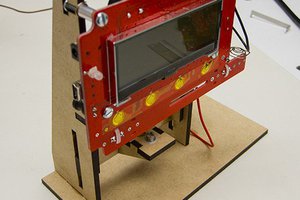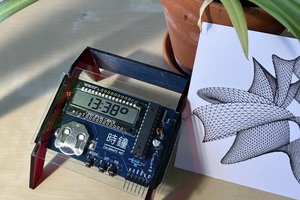A bendulum is topped with a weight. If you give the top a push, it sways back and forth periodically. The motion is much like a pendulum, except that instead of swinging rigidly from a pivot and moving the most at the bottom, the bendulum’s stem flexes across its narrow dimension and the motion is most pronounced at the top.
Like a pendulum a bendulum is approximately isochronous,
meaning that its period is not too dependent on the amplitude of its
swing or on the ambient temperature. Also like a pendulum, a bendulum is
more accurately isochronous if the swing amplitude is small.
Since a bendulum is close to isochronous, its periodicity can be used to drive a clock. To do so it needs to be equipped with a mechanism that does two things. It needs to detect when the bendulum passes through the center of its swing and it needs to give the bendulum precisely the same little push each time it passes to keep it going. In a pendulum clock such a mechanism is called an “escapement,” and that’s what we call it here, too.
The bendulum escapement discussed here uses a strong button magnet for the bendulum weight and swings it past a many-turn coil of fine copper wire located at the center of the bendulum’s swing. The coil is attached, via a custom Arduino shield, to an analog input and a digital output of an Arduino Uno microcontroller. When the magnet swings past the coil, it induces a small pulse of electricity that the sketch running in the Arduino detects on the analog input. Very quickly thereafter, the sketch uses the Arduino’s digital output to send a short pulse through the coil. The pulse induces a magnetic field in the coil which gives the magnet the little push it needs.
The bendulum clock project started a few years ago from reading the Make magazine (volume 28, p 148) description of the solar pendulum build by Owen Tanner. Thinking it would be interesting to build one of my own, I ordered a couple of the Solarbotics solar pendulum parts bundles.
The central idea that grabbed me about the solar pendulum’s design right from the beginning was that it used a single inductive coil both as a sensor and as an actuator. Very clever! And that got me to thinking about what other things besides a pendulum I could drive and what other circuits I could use to drive them.
A series of experiments led me to the notion of a bendulum and the conjecture that it ought to be possible to build a bendulum-driven clock. You can, but not using an elaboration of the solar pendulum circuit. The push the circuit gives to the bendulum to keep it going is too temperature dependent and doesn't repeat accurately enough. That makes the bendulum less isochronous than it needs to be. Fortunately, there are other ways to drive a bendulum, and, as it happens, one based on an Arduino works well.
 Dave Ehnebuske
Dave Ehnebuske

 EBP Controller
EBP Controller
 Gabor
Gabor
 Henry York
Henry York